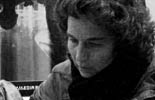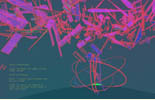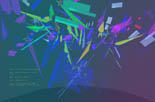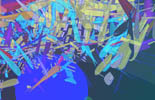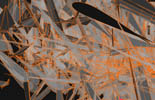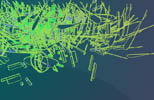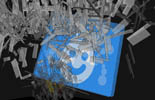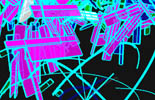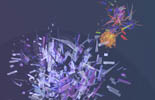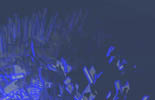FLUXUS - The Art of Conversation
Fluxus is an exploration of the art of conversation. In a digital environment dominated by
emoticons and abrvʼs, Team Fluxus has created a system which abstractly elevates standard text chat to a stimulating,
organic, and emotive visual experience.
Fluxus Demo
The conceptual underpinning of the world of fluxus is visual abstraction of text-based communication in a virtual environment. Fluxus uses a precise formula where a 3D shape represents a consonant and the vowels combine to determine the colour of the word-shapes.
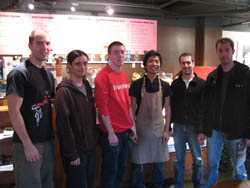
The team working weekends in Jason's coffee shop Cube Coffee on 41st Ave in Vancouver. Best coffee in town!
These elements combined generate an organic visual representation of the conversation, adding another layer of expression and interpretation to standard text based communication. And although the visualization method is abstract it is intended to add a further layer of meaning to the conversation in a similar way that abstract visual art adds meaning to experience.
The Inspiration
Stylistically, fluxus draws inspiration from the Dutch artistic movement
De Stijl.
The movement sought to distill objects through pure abstraction using the most basic of shapes and colours.
The movement strives to ignore the natural form of colour of an object and focus on the abstraction.
So too the world of fluxus does not express the content of a conversation but
rather the universality as captured through abstraction.
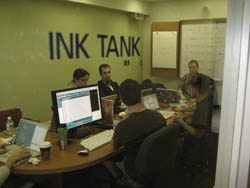
Team Fluxus found a new home
Glowing Spere
Matt: With this Processing experiment I decided to try and draw 3d effects around a single point, while revolving around an object; in this case, a sphere. We used this as a rough template to how effects around the avatar might look, although typing reaction/functionality was not present yet.
The Technology
Fluxus was created using the programming language Processing
and the visual library controlP5.
Processing is a java based open source language designed for the visual arts.
It has been used by artists and designers the world over, notably bands such as Radiohead and R.E.M.
have used it in their music videos.
Glow Sphere Type
Mark: To work out the basic responsiveness of the avatars, I experimented with this simple rotating sphere that responds to a user's key presses by changing colour and and shrinking the length of the rectangles.
In addition to creating a system that visualizes textual communication fluxus was also incorporated into an existing networked virtual environment. To achieve our vision of a 3D organic environment within the existing virtual framework we changed the existing rendering architecture from the jMonkey Engine to Processing, transforming the visual window to the world.
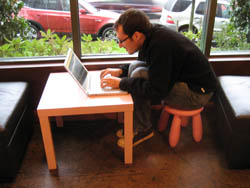
Ken working on the kids table at the Coffee Cube
We hope to build out fluxus for a wider range of applications, namely a web application that enables users to visualize segments of text and a performance art tool where speakers can project a text visualization of their presentation.
The Process
The assignment that inspired fluxus was to create a communication system for a networked virtual environment.
Our first brain storming session evolved from a very accurate reenactment of the scene from the movie
Big where
Tom Hanks dances on the piano floor. From there the notion of fluxus started to emerge.
Letʼs create a world that reacts to the conversation. The group quickly locked on the fundamental
notion and started to develop the idea and how we were going to execute it.
Nebula
Matt: This was my first abstract experiment done with Processing. I was rapidly going through tutorials on drawing 3d shapes in the program, and started messing with random and rotate display functions. It served as an initial basis to embody the visual direction the project would be taking throughout its development.
Initially, the technical details were left for Ken and Jason to sort out, while Bryan and Ryan developed the visualization formula and Matt, Mark and Karin worked on the artistic concept.
As everything started to come together Matt, Mark and Bryan started coding in Processing while Karin and Ryan worked on the website and Ken and Jason made everything work seamlessly.




